4 Key Customer Experience Trends for 2021

Customer-centric brands can leverage these four CX trends to deliver great experiences in the year ahead.
At the start of the COVID-19 pandemic, companies scrambled to adapt to what we thought were temporary changes in consumer behavior. For example, retailers rushed to make curbside pickup available to keep contact to a minimum—while still maintaining sales. And eCommerce businesses—including Amazon—hired more warehouse workers and delivery drivers to keep up with the surge in online sales.
Now that we’re a year into this pandemic, it’s become clear that many of the consumer habits and preferences we thought were fleeting may actually be here to stay.
The good news is, many brands have found their footing and are now making it a priority to fine-tune their customer experience (CX) efforts to better meet the needs and expectations of today’s shoppers. In fact, Forrester predicts that a quarter of brands will achieve statistically significant advances in CX quality in 2021.
Providing great experiences through the purchase journey is essential. According to Salesforce’s most recent State of the Connected Consumer report, 79% of consumers say that the experience a company provides is just as important as its products or services.
But in order to build and optimize great experiences, you’ve first got to understand what matters most to today’s consumers.
In this blog, we’ll explore four of the year’s most important CX trends—and how these trends can shape your CX strategy in 2021 and beyond.
Get the Free eBook: State of Reviews and Q&A 2021 >
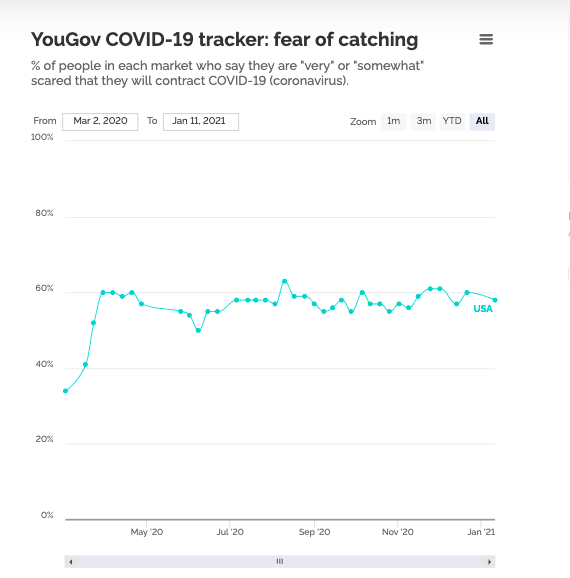
1. Health and Safety Continue to Be a Top Priority
The pandemic has made health and safety top of mind for nearly all consumers; this will likely be the case for the foreseeable future. According to a survey from YouGov, at the time of this writing, 58% of Americans are at least somewhat concerned about catching COVID-19.
While a growing number of people are shopping online to minimize risk, there are still plenty of consumers who are visiting brick-and-mortar businesses like stores, restaurants, banks and hotels. Consumers must be able to trust that these in-person businesses are doing everything they can to protect their staff and customers. According to Salesforce’s State of the Connected Consumer report, 82% of consumers say a company’s trustworthiness matters more now than it did a year ago. What’s more, 90% say that how a company acts during a crisis reveals its trustworthiness.
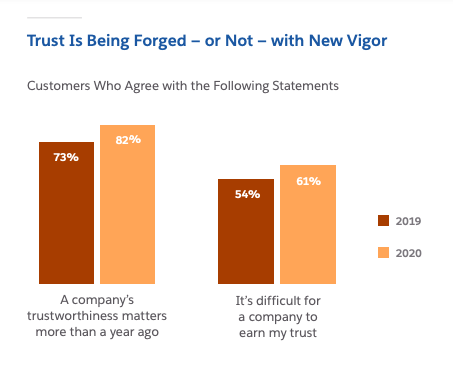 Of course, it’s critical to have safety protocols and procedures in place that are well documented. But that’s not enough. By now, we’ve all heard stories about businesses that display signage about mask requirements — but don’t actually enforce those policies.
Of course, it’s critical to have safety protocols and procedures in place that are well documented. But that’s not enough. By now, we’ve all heard stories about businesses that display signage about mask requirements — but don’t actually enforce those policies.
What helps businesses earn the trust of COVID-conscious shoppers? Reviews.
Location reviews help customers understand which businesses to visit—and which to avoid. For example, if I was in the mood for pizza, I’d be encouraged to give this place a shot because of this review (and others like it) that mentions the restaurant’s COVID protocols.
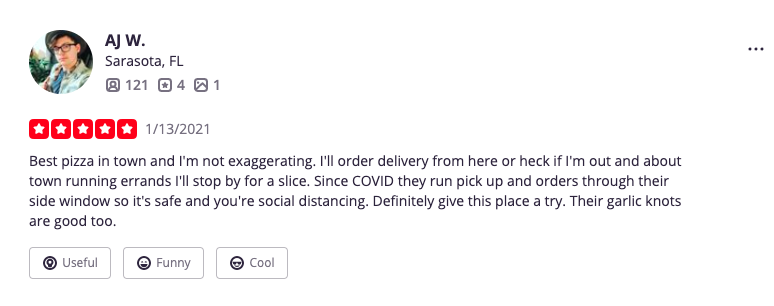
On the other hand, I’d probably avoid this place:
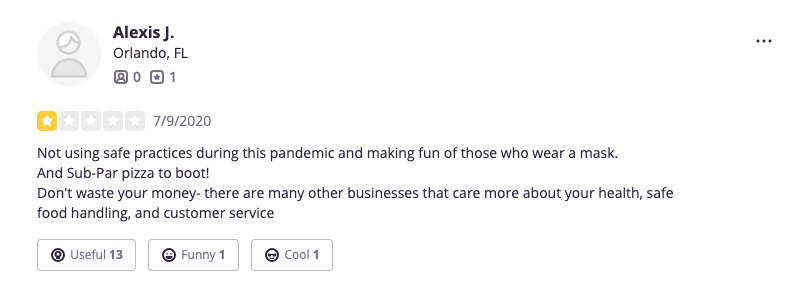
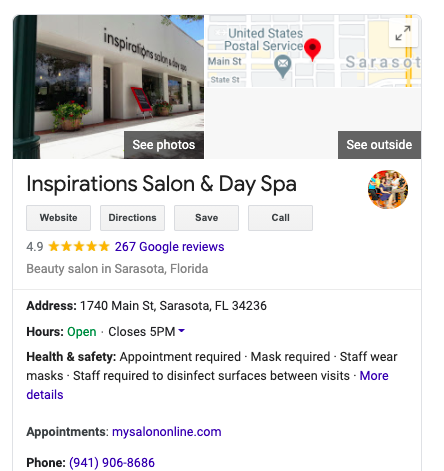 Sites like Google and Yelp are putting health and safety information front and center to make it even easier for consumers to make good decisions. They now display COVID-19 updates for businesses, which are based on information from the business itself—as well as reviewers. Plus, according to an article from CNN Business, Yelp will now display an orange question mark on the pages of businesses not following COVID-19 recommendations.
Sites like Google and Yelp are putting health and safety information front and center to make it even easier for consumers to make good decisions. They now display COVID-19 updates for businesses, which are based on information from the business itself—as well as reviewers. Plus, according to an article from CNN Business, Yelp will now display an orange question mark on the pages of businesses not following COVID-19 recommendations.
Online shoppers also turn to reviews to ensure a business is prioritizing health and safety. For example, in the midst of the global health crisis, there’s been a big uptick in online sales of N95 masks and hand sanitizer. But reviews like this one for an N95 mask alert shoppers that a safety product may actually be phony or ineffective.
Product and location reviews help you earn the trust of the many shoppers concerned about health and safety. So be sure you’re actively managing the reviews your customers are writing. If you’re a Reputation Studio customer, it’s easy to manage all of your reviews from a single platform.

And if a review comes through that mentions phony products or COVID concerns, make it a priority to investigate the issue and respond as soon as possible. Avoid getting defensive. Instead, apologize and determine what you can do to make things better. It’ll show the review writer (and future customers) that their health and safety is your top priority.
2. Empathetic Customer Care is More Important Than Ever
Of course, the experiences a customer has before the sale are important. But the experiences that come after the sale are just as important (if not more!).
Customer care teams have always played a starring role in delivering great post-sale experiences to shoppers. Today, these teams have never been more important. But where and how they deliver great service is changing.
 For starters, more consumers are seeking out customer service via digital channels. According to Salesforce’s State of Service report, 87% of service professionals say customers have increased their use of digital channels during the pandemic. And Forrester predicts that in 2021, digital customer service interactions will increase by 40%.
For starters, more consumers are seeking out customer service via digital channels. According to Salesforce’s State of Service report, 87% of service professionals say customers have increased their use of digital channels during the pandemic. And Forrester predicts that in 2021, digital customer service interactions will increase by 40%.
Brands must ensure their customer care teams are equipped to handle the influx of customer service inquiries coming in through digital channels including web forms, live chat and reviews. While automation can certainly help ease the burden, it’s important to remember that machines can’t replace the human touch. For example, bots have come a long way and can be a useful tool for solving simple problems. But there’s got to be a real person on the other side of that live chat, web form or review when automated tools won’t cut it.
Customer care teams are also dealing with an influx of complicated situations from anxious consumers. In the midst of the pandemic, many are concerned about health and safety. And due to high unemployment (and underemployment), many are struggling to pay for the basics like food and household bills.
Now, more than ever, customer care teams must deliver empathetic, flexible service. Those that do will earn the loyalty of shoppers. According to Salesforce, 71% of consumers say that businesses that show empathy during the pandemic have earned their loyalty.
What’s more, organizations must provide personalized service experiences; shoppers don’t want to be treated like a number. Customer care professionals should have visibility into a customer’s orders and previous cases in order to provide great, personalized service. In fact, Salesforce found that 79% of service professionals say it’s impossible to provide great service without full customer context.
Another important way to provide personalized service is by making it available in the customer’s own language. So be sure your customer care professionals have the translation tools they need to communicate with customers in their own language.
3. Consumer Crave Connection and Immersive Experiences
The pandemic has left people feeling isolated and alone. So it’s probably not surprising that many consumers crave engaging, immersive experiences — even when they’re stuck at home.
Case in point? Forrester predicts that in 2021, nearly half of the U.S. online adult population will have tried some form of augmented or virtual reality.
Businesses must provide seamless experiences, regardless of whether a customer is shopping online or in a brick-and-mortar store. And they must think creatively to deliver unique, immersive experiences—even when the shopper isn’t leaving home. For example, beauty brands, including MAC Cosmetics, offer shoppers the opportunity to virtually “try on” hundreds of makeup products—right from their computers or mobile devices.
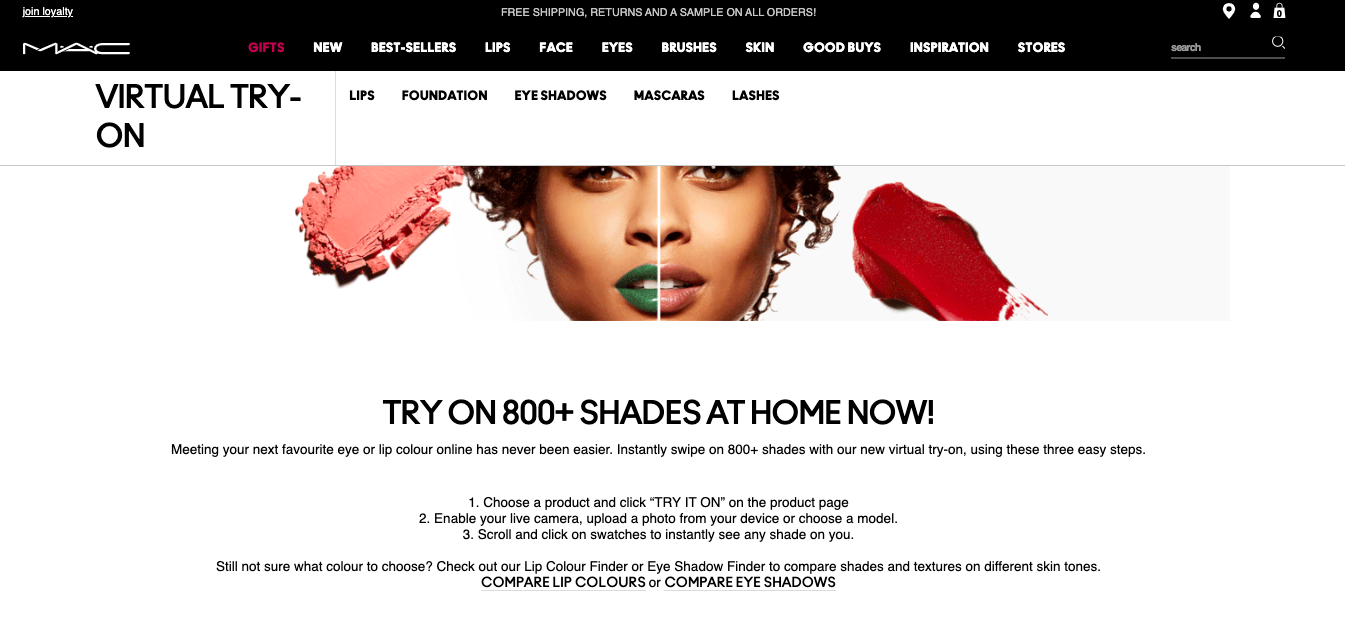
And athletic brand Lululemon offers 1:1 virtual shopping appointments, where shoppers are paired with team members for face-to-face video consultations.
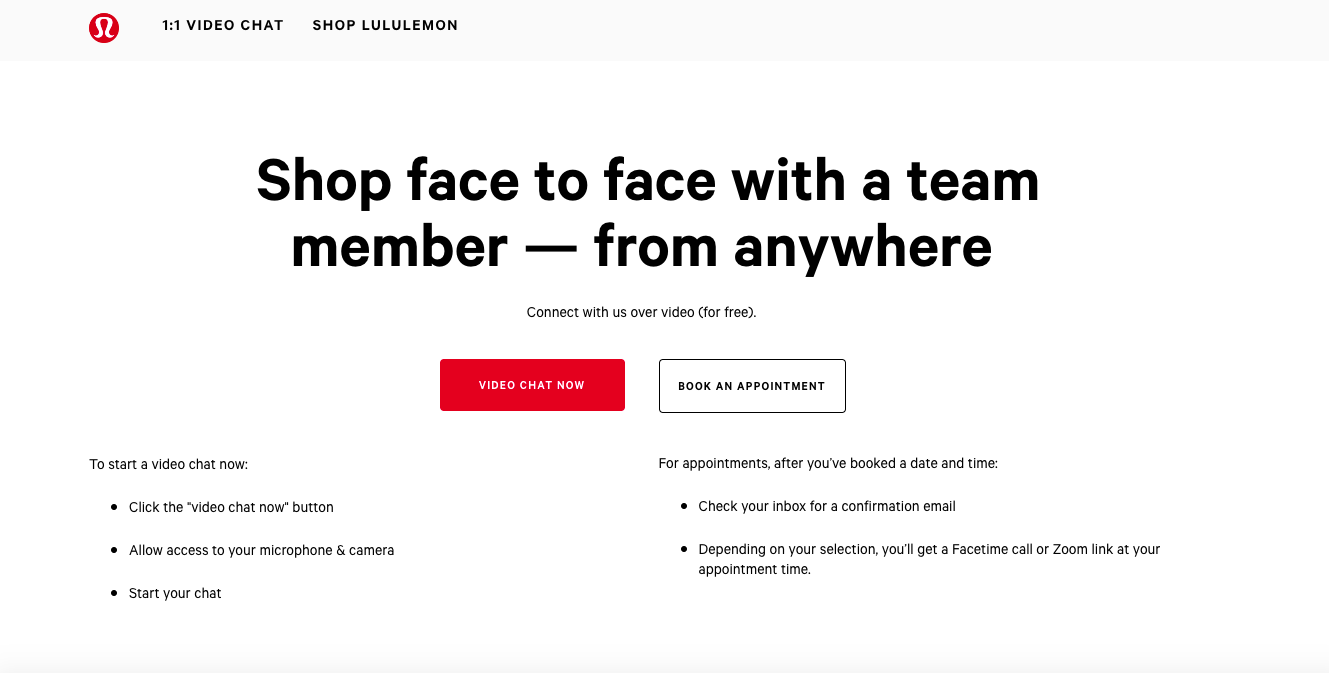
Isolated consumers crave connections with other humans, too. Of course, there are a variety of ways brands can make authentic connections with consumers. But one simple way is by responding to the reviews and questions your shoppers post. They might not expect a response. But getting one assures them you appreciate their business and care about their feedback. And that can go a long way! Down the road, your shoppers will remember how you made them feel during this especially challenging time.
4. Great Experiences are Fueled by the Right Data and Insights
According to Forrester, “insight-driven firms outperform their peers.” So it makes sense why many organizations are increasing their spending on data and analytics. What’s more, 60% of firms globally now have a Chief Data Officer.
But simply gathering data isn’t enough. Instead, you’ve got to collect the right data. Forrester predicts that Customer Insights leaders will shift 10% of their budgets to emotion analytics, as emotion is a powerful driver of consumer behavior.
Then, you’ve got to act on that data in ways that’ll improve customer experience—and boost your bottom line.
Of course, there are many channels to collect and analyze data and insights. One powerful, yet often overlooked source of data is UGC—specifically reviews and Q&A. In fact, this content is full of rich insights that can be used to improve your products and the experiences you provide your customers.
Keep a Pulse on Key CX Trends to Drive Business Results in the Year Ahead
The COVID-19 pandemic—and the resulting economic crisis—have had a profound impact on the preferences and expectations of shoppers. The experiences your shoppers loved just a year ago may no longer cut it.
The most successful brands will be those that always keep a pulse on consumer shopping behavior—and consistently adapt their CX strategies to meet the ever-changing needs and preferences of their shoppers.
